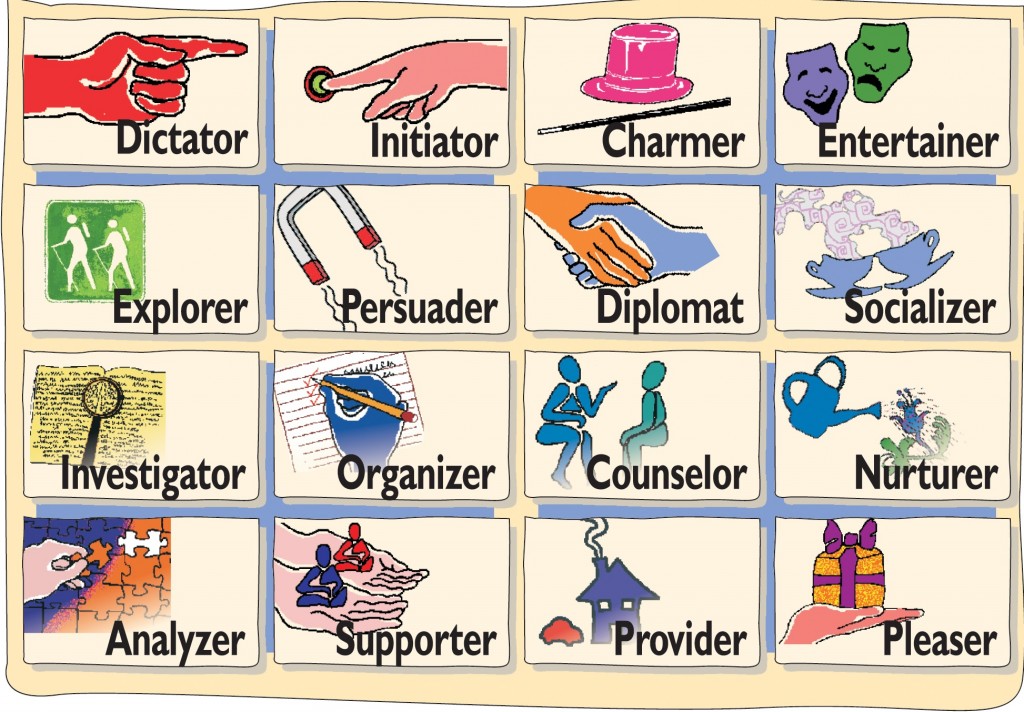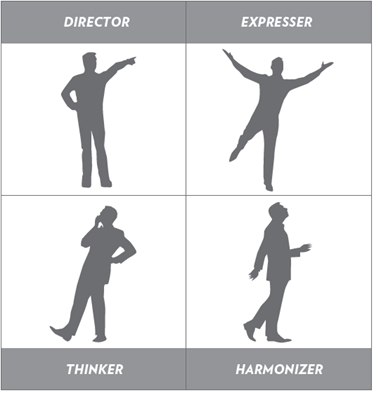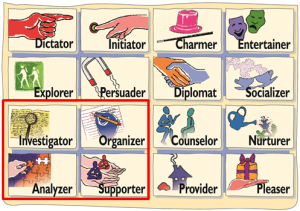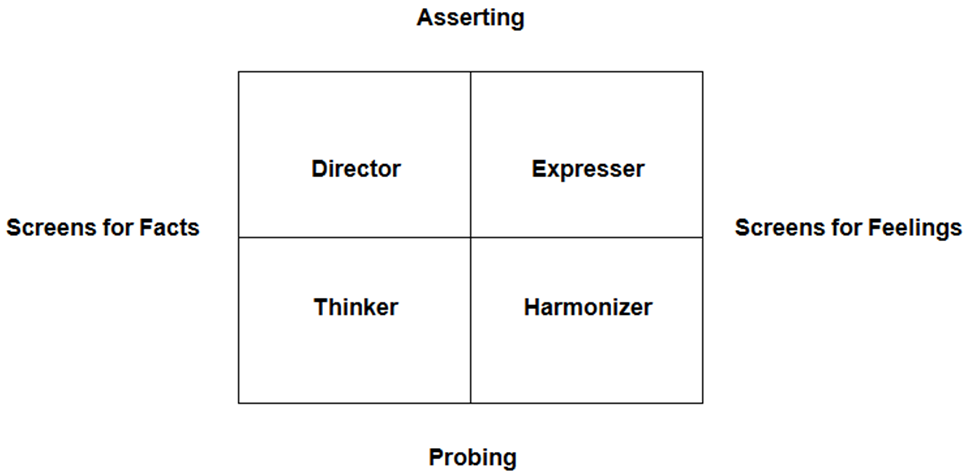
The Matrix of Communication Styles
 Understanding your style of communicating would be relatively easy if you limited yourself to one of the four basic styles. However, depending on the situation, you may alternate between one, two, or even three styles. It’s like walking. You naturally walk at a certain pace. But then you shift gears to match the pace of someone next to you.
Understanding your style of communicating would be relatively easy if you limited yourself to one of the four basic styles. However, depending on the situation, you may alternate between one, two, or even three styles. It’s like walking. You naturally walk at a certain pace. But then you shift gears to match the pace of someone next to you.
It’s the same with communicating. People prefer to use one style. Our “primary style” is the one we’re most comfortable with. But we also have a backup style. Typically, this second style is dictated by our situation — the demands of our particular job if at work, the demands of domestic life if at home.
We refer to the backup style as our “secondary style.” Most people vacillate frequently between their primary and secondary styles. As a result, our overall or specific style becomes a combination of these two styles. It’s like mixing lemon into tea: The concoction has a flavor all its own.
In this lesson, you will learn about your unique flavor. For example, if the Survey revealed your primary style to be Director and your secondary style to be Harmonizer, then this creates an identifiable pattern of communicating called the Persuader. This style is highlighted below.
Once you instill in your mind a mental image of the Matrix, you can use it to identify another person’s communication style, even if he or she hasn’t taken the survey. (Identifying another person’s style is covered in detail in Lesson 4.)
How the Matrix of Communication Styles Works
If you split the Matrix into equal quarters, or quadrants, then each quadrant illustrates a primary style—Director, Expresser, Thinker, or Harmonizer.

Each quadrant contains four more squares. Your secondary style determines your particular square within each quadrant.
Here’s how it works, using the Organizer as an example:
 Step 1: Your primary style governs your placement in one of the four quadrants of the Matrix.
Step 1: Your primary style governs your placement in one of the four quadrants of the Matrix.
- Directors are in the upper left of the Matrix.
- Expressers are in the upper right.
- Thinkers are in the lower left.
- Harmonizers are in the lower right.
Since the Organizer’s primary style is Thinker, he’s in the lower-left quadrant.
Step 2: Once you’ve located your quadrant, cover up the other three. Pretend they don’t exist. In this case, you’d cover up the top half of the Matrix and the lower-right quadrant. The only quadrant visible would be the Thinker.
 Step 3: The Thinker quadrant is divided into four smaller squares. Each has a label, like Investigator or Supporter. Use the same rule of thumb as the first step. If your secondary style is Director, then the upper-left square is your square (Investigator): if your secondary style is Expresser, then the upper-right square (Organizer) represents you.; if your secondary is also Thinker, then the lower-left square is yours (Analyzer); and if your secondary style is Harmonizer, then the lower-right square is yours (Supporter). In this case, the secondary style is Expresser, which makes this person an Organizer.
Step 3: The Thinker quadrant is divided into four smaller squares. Each has a label, like Investigator or Supporter. Use the same rule of thumb as the first step. If your secondary style is Director, then the upper-left square is your square (Investigator): if your secondary style is Expresser, then the upper-right square (Organizer) represents you.; if your secondary is also Thinker, then the lower-left square is yours (Analyzer); and if your secondary style is Harmonizer, then the lower-right square is yours (Supporter). In this case, the secondary style is Expresser, which makes this person an Organizer.
Download the PDF – “The Sixteen Specific Communication Styles”
Filters and Frames
The Matrix is a very helpful tool because it lets you see the relationship between all sixteen styles at a glance. You can see how the styles at the top of the Matrix are the most assertive, while those at the bottom are the least so. How those on the left side are most analytical, while those on the right are the most intuitive. Take the survey!
Corner Styles
Some people—approximately one in a hundred—are so-called “corner styles.” The four corner styles are Director, Entertainer, Analyzer, and Pleaser. Corner styles occur when a person’s score for one basic communication style is ten points higher than the score for any of the others.
Corner styles have particular challenges to face in developing their communication skills. Because they don’t regularly use a secondary, backup style, their communications tend to be less adaptable and flexible. These challenges are discussed under the description for each corner style in The Sixteen Communication Styles (PDF).
Blended Styles
Some people truly have two styles and occupy two places on the Matrix. We call these people “blended styles.” A blended style occurs when a person’s high score is identical for two of the basic communication styles. For example, a person who scores 35 for both Thinker and Director would be a blend of Investigator and Explorer.
If you have a blended style, don’t worry. It’s a perfectly natural outgrowth of the way the survey is constructed. Taking the survey again might slightly alter your score, and thus give you a neater fit within a particular square on the Matrix. But your score the first time you take the survey is typically the truest reflection of your style. And a person who has a blended style can get just as much out of Straight Talk as someone who occupies a single square on the Matrix.
After you read the descriptions of each specific style, it may be readily evident which specific style is yours. If so, adopt it as your own. But if you are still wavering between two styles, accept your fate. The purpose of the Matrix is to help you improve your communications, not to shoehorn you into a particular category or give you a label.
Conclusion
As you begin to familiarize yourself with each style, certain themes begin to emerge about what constitutes a competent communicator. The importance of asking good questions. The need to assert one’s own beliefs and feelings clearly and honestly. The importance of getting all the facts before you draw conclusions. The need to distinguish between asking pertinent questions and conducting a self-serving interrogation. The value of active listening — paraphrasing what another person says to confirm your understanding of the situation.
Once you start to appreciate the full spectrum of styles, you can also begin fitting your colleagues and friends into the Matrix. You can start to appreciate the dynamic shifts between communication styles. You can see how those styles at the top of the Matrix are the most assertive, while those at the bottom are the least assertive. How those on the left side are the most analytical, while those on the right are the most free-flowing. You can also begin to see how communication styles affect leadership styles.
| Lesson 5: The Four Communication Styles | Lesson 7: The Four Types of Intent |
9 Comments
Add yours+ Leave a Comment
You must be logged in to post a comment.






[…] Lesson 6: The Matrix of Communication Styles […]
[…] Lesson 6: The Matrix of Communication Styles […]
[…] line of communication between you and another person. Once you know someone’s place on the Matrix, a single step can mean the difference between a conversation that falters, and one that exceeds […]
[…] The Matrix of Communication Styles […]
[…] the world as they do. Immerse yourself in their way of thinking. Imagine the world through their filters and frames. Try to understand how their communication style influences the way they live. Study their […]
[…] Matrix of Communication Styles can be somewhat confusing at first, but it’s a very useful tool once you understand how it works. […]
[…] shape how they listen. This is truly powerful listening. As they listen, they are able to apply the matrix of communication styles. They can quickly identify the underlying frame of reference and respond in that frame. For the […]
[…] the Communication Styles Matrix, there are four basic styles of communicators: the Director, Expresser, Thinker, and Harmonizer. […]
[…] The Matrix of Communication Styles […]